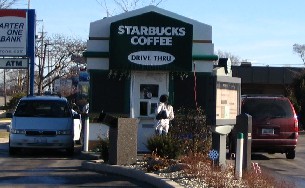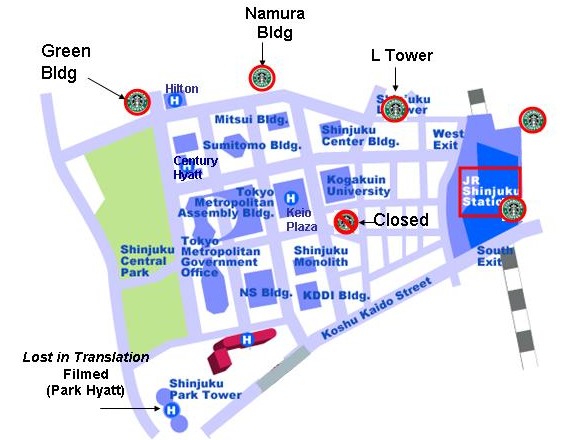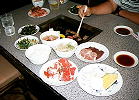Disclaimer: I have no direct experience with any of the below except Hostess Clubs. This info is from locals and offbeat guidebooks, with the gaps filled in from the internet. (Ed: Mitch also got permission from Mrs. Director before publishing)
Most people know there are large differences between Eastern and Western cultures in their attitudes towards sex. This becomes pretty obvious after only a short time in Japan: men have pictures of women other than their wife on their desk, they openly talk about seeing their "girlfriend" that evening before going home to the wife, men openly read sexually explicit
manga or even "real" pornography in public with as much nonchalance as if they were reading
Time or
People.
In addition there are various thriving businesses catering to pretty much any sexual desire a man may have ranging from flirting to fetish. Here is a listing, starting with the tamest and going downhill:
Geisha - Thirty years ago most Americans thought Geisha was synonymous with prostitute, but I think from books and documentaries that Americans today know that Geisha means "artist" and they are nothing more than entertainers who take years to learn song, dance and instruments. They typically provide entertainment, conversation and light flirting to small parties of businessmen and are very, very expensive. Most geisha today are centered near the cultural capital of Kyoto.
As shown in the fictional but well researched book
Memoirs of a Geisha, many enter long-term social and physical relationships with well established men of means, but this is no different than the majority of housewives in Newport Beach.
Hostess Clubs - Start with a Geisha, take away the art, leave the flirting, and you have a Hostess. Hostess Clubs are bars and karioke parlors where girls provide talk, flirt, keep your glass full with your favorite beverage, and will sing your favorite karioke song with you. This is a very common form of business entertainment and I have been to dozens of Hostess Clubs in Japan and the U.S. (I even took Mrs. Director to one in Newport Beach when a Japanese friend came into town). Typically nothing more happens than a hostess putting her hand on your arm and telling you "
You are such an important business man. You must be really smart!", giving you quite the ego boost. Like geisha, however, many of the girls will become "girlfriends" of regular clients in a sort of "relationship with financial aid".
Strip Clubs - I think these are a Western import and have actually never seen one. They're here somewhere since one was shown in the movie
Lost in Translation.
Health Clubs (also called "Esute") - Massages are healthy, right? So a health club provides you a massage. There might not seem anything wrong about that, except they also provide what in American parlance is called a "happy ending".
Soaplands - Baths are a part of Japanese culture, so why not go to a place that gives you a bath? And a scrubbing.
All over.
Image Club - I found this one on the internet and it's a little too strange to believe. Essentially it's a brothel where the girls dress up in whatever turns you on: nurse, police woman, etc. The scary part is that "school girl" is one of the costumes. You don't have to be here long to know that Japanese men have a thing about this. The covers of adult magazines in the train stations often have adult models posing in school uniforms, which is rather creepy.
You can find a few other types of sexually oriented businesses here if you do an internet search. It's pretty surprising, but you have to keep in mind they have a totally different culture.
I do believe, however, that over time the mores of the Japanese are becoming closer to the West, so my guess is that many of the more explicit types of businesses will be gone in a generation or two.





 Finding a Starbucks in Shinjuku
Finding a Starbucks in Shinjuku
 Excelsior Coffee - This is a Starbucks wantabe, and where I ended up the first morning when I found my Starbucks missing. The coffee was pretty good, and definitely better than the hotel stuff, but not quite up to par. Their set-ups are nearly identical to Starbucks with comfy chairs and nice seating areas with nice music playing the background. If you can't find a Starbucks, this is a good back-up.
Excelsior Coffee - This is a Starbucks wantabe, and where I ended up the first morning when I found my Starbucks missing. The coffee was pretty good, and definitely better than the hotel stuff, but not quite up to par. Their set-ups are nearly identical to Starbucks with comfy chairs and nice seating areas with nice music playing the background. If you can't find a Starbucks, this is a good back-up. Doutor - These are low-end, "price cutting" coffee shops and all over the place. They are actually
Doutor - These are low-end, "price cutting" coffee shops and all over the place. They are actually  Peet's - I noticed a couple of these. It turns out these are a result of
Peet's - I noticed a couple of these. It turns out these are a result of 
 Don't Bring Fido with You to Korea
Don't Bring Fido with You to Korea
 Teppanyaki - This is "
Teppanyaki - This is " Tonkatsu - This is a breaded pork cutlet, usually served with a side of shredded cabbage. Contrary to what you might think, it is not very heavy at all.
Tonkatsu - This is a breaded pork cutlet, usually served with a side of shredded cabbage. Contrary to what you might think, it is not very heavy at all. Shabu-Shabu - This is a form of cooking where water is boiled and thinly sliced meat and vegetables (and usually some other stuff like tofu) are thrown in to cook for a while before taken out and eaten, at which point more stuff thrown into the pot for the next round. Sort of similar to fondue, except water is used instead of oil.
Shabu-Shabu - This is a form of cooking where water is boiled and thinly sliced meat and vegetables (and usually some other stuff like tofu) are thrown in to cook for a while before taken out and eaten, at which point more stuff thrown into the pot for the next round. Sort of similar to fondue, except water is used instead of oil. Udon, Soba, Raman - These are each a different type of noodle. They are usually served in a bowl with broth, vegetables, and sometimes other stuff like meat, seafood, or tempura (soba is sometimes served alone and eaten cold). This is the Japanese form of fast food.
Udon, Soba, Raman - These are each a different type of noodle. They are usually served in a bowl with broth, vegetables, and sometimes other stuff like meat, seafood, or tempura (soba is sometimes served alone and eaten cold). This is the Japanese form of fast food. Yakitori - This is where meat and vegetables are put onto little skewers and grilled. One of my favorites for a light meal, Yakitori houses are usually little holes in the wall and hard to find.
Yakitori - This is where meat and vegetables are put onto little skewers and grilled. One of my favorites for a light meal, Yakitori houses are usually little holes in the wall and hard to find.  Yakiniku - This is the Japanese form of Korean BBQ where you grill your own marinated meat over a grill at your table. The best Yakiniku place EVER was a place called Santoku in Tokyo but, sadly, it is no longer around. The second best place is in Newport Beach and called Anjin, where my family and friends go frequently.
Yakiniku - This is the Japanese form of Korean BBQ where you grill your own marinated meat over a grill at your table. The best Yakiniku place EVER was a place called Santoku in Tokyo but, sadly, it is no longer around. The second best place is in Newport Beach and called Anjin, where my family and friends go frequently.

